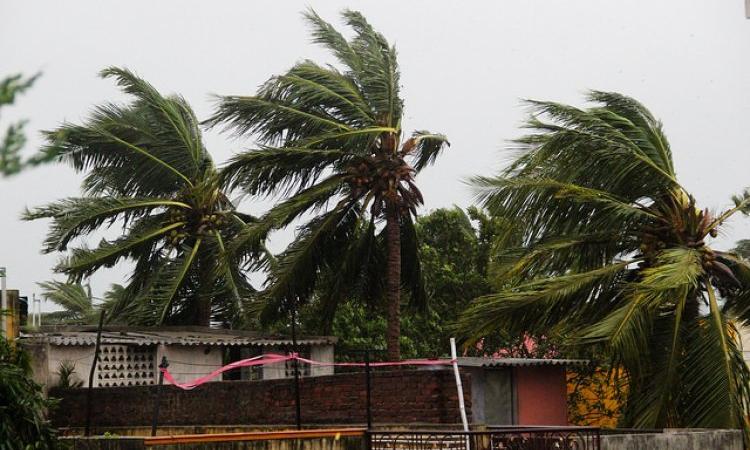
The severe cyclonic storm Vayu that formed over the Arabian Sea was expected to hit Gujarat on June 13, but changed course, skirting Gir, Somnath and Porbandar. The latest news shows that the storm is likely to turn into a depression, reduce in intensity and reach the north Gujarat coast by June 17. India Meteorological Department (IMD) has also informed that wind speeds from 100-125 kilometres per hour are likely over the northeast Arabian sea and areas of northwest and central Arabian sea. Gujarat coasts could experience winds up to 60 kilometres per hour.
This is not the first time that India has experienced cyclones. Some of the worst tropical cyclones that ravaged the country include those like Ockhi (2017), Vardha (2016), Hudhud (2014), Phailin (2013), Nilam (2012), Thane (2011), Jal (2010), Nisha (2008), Fanoos (2005), Sidr (2007), Bhola (1970). Recent evidence shows that the intensity of tropical cyclones during the monsoon period has increased in India. Thus, analysing historical data on cyclones can be of great use for understanding the location, behaviour and risk of cyclones for better preparedness to prevent the destruction that these storms can unleash.
The paper. A study on various tropical cyclone hits in India – Through GIS approach published in the International Journal of Pure and Applied Mathematics presents the findings of a study that attempts to identify:
- The different cyclone-prone areas in India using GIS techniques.
- The different basins of origin of the cyclones and depressions in the Bay of Bengal and the Arabian Sea and their classification
- The path of the cyclone during its journey
Cyclones, a unique phenomenon of nature
What are cyclones?
The word ‘Cyclone’ is derived from the Greek word ‘cyclos’ meaning the coiling of a snake referring to the shape of the airflow while it gradually develops into a full-fledged storm. Tropical cyclones are known by different names in different parts of the world. In the Atlantic and eastern Pacific, they are known as hurricanes and in the western Pacific, as typhoons. In the Indian region, they are referred to as tropical cyclones.
According to the IMD “A tropical cyclone (TC) is a rotational low-pressure system in tropics when the central pressure falls by 5 to 6 hPa from the surrounding and maximum sustained wind speed reaches 34 knots (about 62 kmph). It is a vast violent whirl of 150 to 800 km, spiraling around a centre and progressing along the surface of the sea at a rate of 300 to 500 km a day”
Tropical cyclones can also be referred to as intense warm centred circular speeding vortices that form over the warm tropical oceans. They are characterised by low atmospheric pressure, strong winds, and heavy rain that can have devastating consequences for life, property, and the livelihoods and lives of affected communities.
Types of cyclones
The IMD has classified cyclonic storms into various categories. They can be identified as Depressions (D), Cyclonic Storms (CS) and the Severe Cyclonic storms (SCS) that are formed in the Indian Ocean, Arabian Sea and the Bay of Bengal based on the intensity scale defined by the IMD. The impact of a tropical cyclone can be very disastrous when it is making a landfall due to the strong winds along with heavy rainfall and tidal waves. Depression is the first stage of the formation of a cyclone, which intensifies into a deep depression, then a cyclonic storm and then into a severe and very severe cyclonic storm.
IMD classification of cyclones
The study finds that:
- West Bengal, Orissa and Andhra Pradesh are the states most vulnerable to cyclones in India along with Andaman and Nicobar Islands in the east and Gujarat in the West and also the Lakshadweep Islands
- Historical analysis shows that Orissa, Andhra Pradesh, West Bengal and Andaman and Nicobar Islands are frequently prone to cyclones and depressions that are formed in the Bay of Bengal whereas Gujarat is most vulnerable for tropical cyclones originating in the Arabian Sea
- The most severe cyclones are four times more likely to originate in the Bay of Bengal as compared to the Arabian Sea due to the presence of warm air in the area.
- Among the type of cyclones, depressions are most frequent, followed by cyclonic storms and severe cyclonic storms
- Observations show that all depressions do not develop into cyclonic storms. Historical data shows that many tropical cyclones suddenly deviate along their path during their active period
- Most cyclones occur during September, October and November. The main cyclone season in the South Indian Ocean is May to July and September to December with significant occurrences of storms in April and August.
A copy of the paper can be accessed here
/articles/india-eye-storm